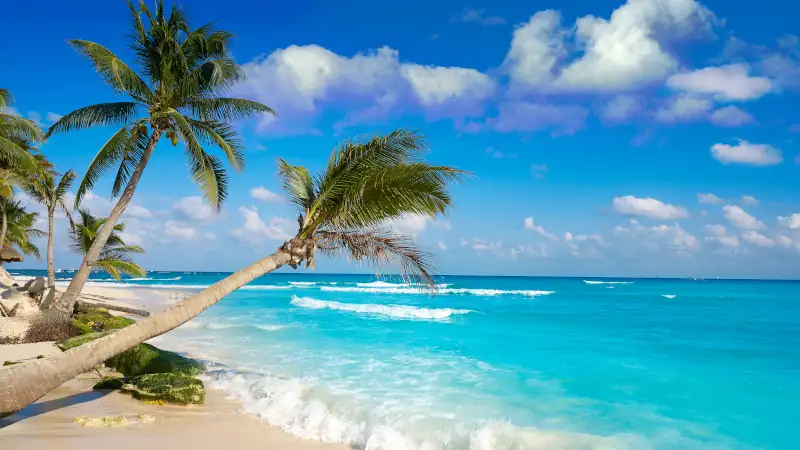The Riviera Maya—the Caribbean coastline that stretches from Cancún to Tulum in southeastern Mexico.
This region is one of a kind. With its turquoise waters, dense jungles, Maya ruins, and natural swimming holes known as cenotes, it feels timeless. Yet it’s well-prepared for modern living, offering everything from eco-adventures and entertainment to high-comfort—even luxury—accommodation.
With major infrastructure projects in the works and international attention at an all-time high, the Riviera Maya is evolving quickly. For lifestyle seekers and investors, now’s the time to take a closer look at this stretch of coast…
Scouting The Riviera Maya
In June, I toured two of the Riviera Maya’s hottest property markets: Tulum and Playa del Carmen.
I met with developers, brokers, and property managers, toured sites from pre-construction to polished condos, and walked away convinced that this region is worth your attention.
Tulum—Boho Chic Meets Global Investment
For years, Tulum was the bohemian cousin to Cancún and Playa. It was less accessible and less developed, but that was part of the appeal, drawing in yogis and eco-tourists. But that reputation is changing…
Two infrastructure developments in particular are transforming Tulum: Tulum International Airport and the Tren Maya, both of which became operational in 2023.
The airport exceeded passenger projections and is expanding the number of destinations it serves. Meantime, the train has made Tulum more accessible than ever.
I arrived the old-fashioned way via Cancún International Airport. It’s an easy two-hour drive past Puerto Morelos, Playa del Carmen, Disney-like eco-attractions from the Xcaret group, and a PGA-certified golf course.
Tulum’s Unique Atmosphere
Tulum is equal parts beach-hippie and jet-set glam.
In the Hotel Zone, you find curated jungle dining, brand-name luxury hotels, and high-end wellness retreats where you can easily break the bank.
People who frequent this area tend to be well-heeled nomads and boho elites, whom locals refer to as the “Tuluminati.” This doesn’t represent all of Tulum, however.
Outside of the hotel zone, you find nice residential neighborhoods that are evolving quickly, each with a distinct personality:
- La Veleta: an up-and-coming area that’s still a construction zone in certain pockets. Roads are often unpaved, but the affordability is drawing first-time investors and smaller-scale developers. You’ll find a selection of nice, mid-range restaurants, cafés, and shops.
- Region 15: one of the most active development zones. Prices here are lower because of the less-mature infrastructure, but investors are buying large tracts to build full-scale communities, often with hundreds of units.
- Aldea Zama: the most polished and established zone. It’s a planned community with paved roads, green spaces, and amenities, and it appeals to buyers looking for comfort and strong rental performance.
- Selva Zama: adjacent to Aldea Zama. It’s not fully developed yet, but it continues the same design and will have the feel of a planned community.
- Centro Tulum: the area along the highway that runs through the center of Tulum. This is where you find all major shops, restaurants, and more—a place of administration and convenience. It’s evolving too, with luxury projects appearing closer to town services and walkable attractions.
Throughout Tulum, a calm, relaxed atmosphere pervades. People cycle from place to place. No one is in a rush or appears stressed. It feels safe, people are friendly, and there’s little to no hustle culture. It has all the ingredients needed for a happy life.
Plus, everything you need is no more than a 10-minute drive (or 15-minute bike ride) in Tulum. You can settle in one neighborhood but enjoy the best of all the other ones.
Tulum Property Market Snapshot
Tulum’s property prices span a wide range, with studios starting around $180,000, two-bedroom condos averaging $250,000 to $400,000, and luxury villas reaching $1 million-plus.
Rental yields for well-managed units near the beach or in popular neighborhoods like Aldea Zama or La Veleta average 6% to 10% annually, depending on amenities, location, and occupancy strategies.
Units with jungle views, rooftop pools, or hotel-style services can command premium nightly rates, especially during peak tourism season from December to April.
Most buyers in Tulum are international, mainly from the U.S., Canada, and parts of Europe.
Short-term vacation rentals are a strong investment play; however, a growing number of digital nomads and semi-permanent residents are increasing demand for longer-term furnished rentals, especially those with co-working spaces or strong internet connections.
What’s Driving Tulum’s Growth?
Three main factors are fueling Tulum’s growth:
- Infrastructure development – Beyond the new airport and train, two malls (one luxury) are under construction, a Walmart and Home Depot are coming, and new beach access roads are being paved.
- Legal and market maturity – Real estate agents must now be certified, bringing professionalism and consumer protection. It’s a buyer’s market, with high inventory right now.
- Variety of property options – From jungle-view condos with rooftop pools to boho-chic studios, there’s something for every budget and preference.
The Growing Pains
Tulum is still grappling with rapid growth and the infrastructural challenges that come with it. Roads in certain areas are chalky, full of potholes, and often flooded in the rainy season.
Sargassum, a type of seaweed, is a seasonal nuisance. While not a problem every year, 2025 has seen a heavy bloom. The beaches I visited were being actively cleaned, but swimming wasn’t appealing.
When the sargassum is in town, people skip the beach and go to cenotes—natural sinkholes that are common in the Yucatan Peninsula, formed by the collapse of limestone into underwater aquifers. There are even cenote clubs with restaurants, bars, and music.
Playa Del Carmen—Well-Established But Still Growing
After Tulum, I continued north to Playa del Carmen, spending time with long-time market insiders and touring active developments.
Unlike Tulum’s boho vibe, Playa is a real city with long-term infrastructure, health care, international schools, and reliable utilities.
Tourists flock here year-round, giving it a steadier rental market. Many North American snowbirds have second homes or long-term rentals.
It’s just 45 minutes from Cancún International Airport. The Tren Maya stops here too, connecting it to the rest of the Yucatán.
Why Playa Works For Investors
Playa del Carmen remains a top pick for investors who prioritize walkability, established services, and steady rental returns. It receives a more consistent flow of tourists than Tulum. Even during the low season when I was there, it was busy.
It has well-paved roads, reliable utilities, high-speed internet, and health care facilities. It also has beach clubs, live music, fine dining, yoga studios, gyms, and international schools. All of this appeals to expats and long-term visitors.
The city is home to several property management companies with decades of experience working with foreign buyers. Many offer turn-key rental options.
Playa Property Market Snapshot
Most expat buyers focus on the zone between the beach and 30th Avenue, especially north of Constituyentes Road. This area offers a mix of convenience and beach proximity.
All of the developers I met with have projects in this area. Developers are well-established, often repeating proven models across multiple projects. Some partner with hotel brands to boost rental demand and management quality.
Studios and one-beds start around $250,000. The average price per square meter is about $6,000, putting Playa on par with Paris’s prices. In the right locations with solid management, 6% to 8% net rental returns are realistic.
Buyers must create a fideicomiso (a bank trust) to hold property here—standard for foreigners buying within 50 kms of the coast. It costs about $2,000 to set up and $400 annually to maintain.
Playa’s Downsides
Playa’s maturity means higher entry costs. For newer investors, $250k can be a stretch. Downtown and the 5th Avenue area can feel crowded and chaotic. It’s a hotbed for tacky tourism, with club noise and cheap trinkets.
The downtown core is largely built out, pushing new developments further inland and sacrificing beach access. The beach itself is not very wide, with only a narrow strip available to enjoy.
Is Now The Time To Invest?
If you’re looking for early-stage potential, Tulum is worth a look. Infrastructure is catching up quickly, the atmosphere remains unique, and there’s still a range of entry points. There’s potential for appreciation.
If you want stability and predictable cash flow, Playa del Carmen is a safe bet. The market is mature, management is professional, and rental demand is consistent.
Both destinations have their quirks and risks, like any real estate market. But the Riviera Maya stands out as one of the most exciting places in Latin America right now.
To smooth travels and successful property buys,


